EASA AIRWORTHINESS DIRECTIVE
EASA AIRWORTHINESS DIRECTIVE
EASA AIRWORTHINESS DIRECTIVE
You also want an ePaper? Increase the reach of your titles
YUMPU automatically turns print PDFs into web optimized ePapers that Google loves.
<strong>EASA</strong> AD No.: 2007-0218R1<strong>EASA</strong><strong>AIRWORTHINESS</strong> <strong>DIRECTIVE</strong>AD No.: 2007-0218R1Date: 28 February 2011Note: This Airworthiness Directive (AD) is issued by <strong>EASA</strong>, acting in accordance withRegulation (EC) No 216/2008 on behalf of the European Community, its Member States andof the European third countries that participate in the activities of <strong>EASA</strong> under Article 66 ofthat Regulation.This AD is issued in accordance with EC 1702/2003, Part 21A.3B. In accordance with EC 2042/2003 Annex I, Part M.A.301, thecontinuing airworthiness of an aircraft shall be ensured by accomplishing any applicable ADs. Consequently, no person may operatean aircraft to which an AD applies, except in accordance with the requirements of that AD, unless otherwise specified by the Agency[EC 2042/2003 Annex I, Part M.A.303] or agreed with the Authority of the State of Registry [EC 216/2008, Article 14(4) exemption].Type Approval Holder’s Name :AIRBUSType/Model designation(s) :A318, A319, A320 and A321 aeroplanesTCDS Number :Foreign AD :Revision :<strong>EASA</strong>.A.064Not applicableThis AD revises <strong>EASA</strong> AD 2007-0218 dated 10 August 2007, which superseded<strong>EASA</strong> AD 2006-0222 dated 20 July 2006.ATA 28Fuel – Main Fuel Pump System / Fuel Pumps – AirworthinessLimitations / Inspection / ReplacementManufacturer(s):Applicability:Airbus (formerly Airbus Industrie)Airbus A318-111, A318-112, A318-121, A318-122, A319-111, A319-112,A319-113, A319-114, A319-115, A319-131, A319-132, A319-133, A320-111,A320-211, A320-212, A320-214, A320-215, A320-216, A320-231, A320-232,A320-233, A321-111, A321-112, A321-131, A321-211, A321-212, A321-213,A321-231 and A321-232 aeroplanes, all manufacturer serial numbers, ifequipped with fuel pumps manufactured by Eaton Aerospace Limited(formerly FR-HITEMP Limited) with Part Number (P/N) 568-1-27202-001,P/N 568-1-27202-002 or P/N 568-1-27202-005.Note: Aeroplanes on which fuel pumps have not been modified or replacedsince embodiment of Airbus modification 37508 in production are not affectedby the requirements of this AD.Reason: An operator reported a failure of a type 8410 fuel pump P/N 568-1-27202-005in service. Subsequent investigation revealed that the cause of the pumpfailure was due to one of the two screws and nuts holding the gas returnconnector to the top of the motor housing had become unscrewed. The screwdropped between the motor rotor and the stator where it caused the shortcircuit resulting in the circuit breaker tripping. Further investigation concludedthat this was due to the inadequate locking mechanism of the nut and thescrew being incorrectly torque tightened.Consequently, the integrity of the pump’s explosion proof housing is not keptand arcing may occur during the failure. In case the pump is not submergedin fuel, an explosion could occur both in-flight or on ground.<strong>EASA</strong> Form 110 Page 1/5
<strong>EASA</strong> AD No.: 2007-0218R1As a result, on 02 May 2006, <strong>EASA</strong> issued Emergency AD 2006-0106-E tomandate Aircraft Fight Manual (AFM) limitations and airworthiness limitations.Subsequently, <strong>EASA</strong> AD 2006-0222 was issued to retain the AFM limitationsand airworthiness limitations, superseding <strong>EASA</strong> AD 2006-0106-E, and torequire modification of the affected pumps.Further investigations have revealed that all of the Eaton type 8410 fuelpumps, P/N 568-1-27202-001, P/N 568-1-27202-002 and P/N 568-1-27202-005, can be affected.For that reason, <strong>EASA</strong> AD 2007-0218 was issued, retaining the requirementsof <strong>EASA</strong> AD 2006-0222, which was superseded, and expanded theapplicability to require the modification or replacement of all affected pumps.This AD has been revised to clarify the applicability.Effective Date: Revision 1 : 14 March 2011Original issue : 07 September 2007Required Action(s)and ComplianceTime(s):Required as indicated, unless accomplished previously:A. AFM and Airworthiness limitations applicable to all aeroplanes:Before next flight after 07 September 2007 (the effective date of theoriginal issue of this AD), amend the applicable AFM to incorporate thefollowing procedure, which is to be applied at each fuel loading:A.1 Refuelling :Before refuelling, all pumps must be turned off, in order to prevent themfrom automatically starting during the refuelling process.A.2 Ground fuel transfer :For all aeroplanes, do not start a fuel transfer from any wing tank, if itcontains less than 700 kg (1 550 lbs) of fuel.For A318, A319, and A320 aeroplanes with a centre tank, do not start afuel transfer from the centre tank, if it contains less than 2 000 kg (4500lbs) of fuel.If a tank has less than the required quantity, it is necessary to add fuel(via a transfer from another tank or refuelling) to enable a transfer totake place.A.3 DefuelingFor all aeroplanes, when defueling the wings, do not start the fuelpumps if the fuel quantity in the inner tank (wing tank for A321) is below700 kg (1 550 lbs). If the fuel on the aeroplanes is not sufficient toachieve the required fuel distribution, then transfer fuel or refuel theaeroplanes to obtain the required fuel quantity in the wing tank.For A318, A319, and A320 aeroplanes with a centre tank, whenperforming a pressure defuel of the centre tank, make sure that thecentre tank contains at least 2 000 kg (4 500 lbs) of fuel. If it has lessthan the required quantity, then transfer fuel to the centre tank. Defuelthe aeroplanes normally, and turn OFF the centre tank pumpsimmediately after the FAULT light on the corresponding pushbuttonswitchcomes on.B. AFM limitation applicable to aeroplanes fitted with centre tank(mod 20024), excluding A321 aeroplanes, all models:Before next flight after 07 September 2007 (the effective date of theoriginal issue of this AD), amend the applicable AFM to incorporate the<strong>EASA</strong> Form 110 Page 2/5
following procedure, applicable for all flights:<strong>EASA</strong> AD No.: 2007-0218R1Note: Only if it is confirmed by the maintenance/engineeringpersonnel that the flight is going to be performed with:- centre tank pumps not in the affected batch, or- centre tank de-activated in accordance with AMM task 28-21-00-040-00200,then the following procedure does not apply.CENTRE TANK PUMPS OPERATION PROCEDURE :WARNING:Do not turn on the centre tank pumps when the centre tankcontains less than 2 000 kg (4 500 lb) of fuel, even if it isrequested by another procedure.Before and during refuelling, turn all tank pumps off.■ If the total FOB after refuelling is less than or equal to 12 000 kg(26 500 lbs):On ground, after refuelling:- Check that the centre tank is empty.Note: If it is not empty, the fuel contained in the centre tank must beconsidered unusable.- Turn on all wing tank pumps- Maintain both centre tank pumps off- Turn FUEL MODE SEL to MAN■ If the total FOB after refuelling is more than 12 000 kg (26 500 lb):On ground, after refuelling:- Check that the centre tank contains at least 2 000 kg (4 500 lbs) offuel.Note: If the fuel quantity is less than 2 000 kg (4 500 lbs), leave bothcentre tank pumps off for the rest of the flight, consider centre tank fuelunusable and do not apply subsequent procedures.- Turn on all wing tank pumps- If the fuel quantity in the centre tank is above 3 000 kg (6 500 lbs),turn on both centre tank pumps.- Monitor the fuel quantity in the centre tank.● When the fuel quantity in the centre tank is between 2 000 kg (4 500lbs) and 3 000 kg (6 500 lbs):- Turn FUEL MODE SEL to MAN- Turn or maintain off both centre tank pumpsNote: If the fuel quantity in the centre tank inadvertently gets below2 000 kg (4 500 lbs) prior to being checked and centre tank pumpshave not been turned off, the flight crew must perform the followingsteps :• If the fuel in the centre tank is required for the flight, leave the centretank pumps in ON position and turn FUEL MODE SEL to MAN. WhenFUEL CTR TK PUMP 1 or PUMP 2 or PUMPS LO PR is triggered on<strong>EASA</strong> Form 110 Page 3/5
<strong>EASA</strong> AD No.: 2007-0218R1the ECAM, or, when the centre tank is empty, turn off the centre tankpumps without delay. Do not apply the subsequent procedures.• If the fuel in the centre tank is not required for the flight, turn off bothcentre tank pumps and do not turn them back on for the rest of theflight. Consider the centre tank fuel unusable. Do not apply thesubsequent procedures.● When FUEL AUTO FEED FAULT is triggered on the ECAM, or thefuel quantity in one wing tank (inner + outer) is below 5 000 kg (11 000lbs):- Turn on both centre tank pumps● If FUEL CTR TK PUMP 1(2) LO PR is triggered on the ECAM :- Turn off the associated centre tank pumpCAUTION:Turn off associated centre tank pumps without delay.● If no fuel leak:- Open the crossfeed valve.● When FUEL CTR TK PUMPS LO PR is triggered on the ECAM, orwhen the centre tank is empty :- Turn off both centre tank pumps and close the crossfeed valve.CAUTION:Turn off both centre tank pumps without delayInserting a copy of this AD, or AFM TR 4.03.00/28 issue 02, into theAeroplane Operations Manual, as well as in the AFM, and strictadherence by the crew is acceptable to comply with paragraph B of thisAD.C. Identification and Replacement of Fuel Pumps :Within 5 000 flight hours or 18 months, whichever occurs first after07 September 2007 (the effective date of the original issue of this AD),identify the P/N of the fuel pumps and, depending on findings, modify orreplace the fuel pump(s) in accordance with the instructions of AirbusSB A320-28-1159.Modification of an aeroplane by installing fuel pumps that have beenmodified in accordance with Airbus SB A320-28-1159 at all applicablelocations constitutes terminating action for the requirements ofparagraphs A and B of this AD for that aeroplane, and/or updates pumpinterchangeability. As a consequence, the AFM changes may beremoved from the aeroplane.From 18 months after 07 September 2007 (the effective date of theoriginal issue of this AD), do not install any Eaton fuel pump type 8410with P/N 568-1-27202-001, P/N 568-1-27202-002 or P/N 568-1-27202-005 on an aeroplane.<strong>EASA</strong> Form 110 Page 4/5
<strong>EASA</strong> AD No.: 2007-0218R1Ref. Publications:Remarks :AIRBUS SB A320-28-1159 original issue.The use of later approved revisions of this document is acceptable forcompliance with the requirements of this AD.AIRBUS AFM TR 4.03.00/28 issue 02.1. If requested and appropriately substantiated, <strong>EASA</strong> can approveAlternative Methods of Compliance for this AD.2. The original issue of this AD was posted on 13 June 2007 as PAD 07-093for consultation until 04 July 2007. The Comment Response Documentcan be found at http://ad.easa.europa.eu.3. Enquiries regarding this AD should be referred to the AirworthinessDirectives, Safety Management & Research Section, CertificationDirectorate, <strong>EASA</strong>. E-mail ADs@easa.europa.eu.4. For any question concerning the technical content of the requirements inthis AD, please contact: AIRBUS – Airworthiness Office – EAS E-mail:account.airworth-eas@airbus.com.<strong>EASA</strong> Form 110 Page 5/5


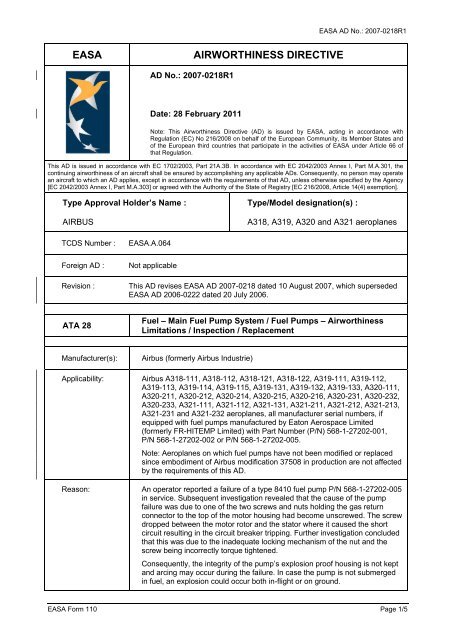
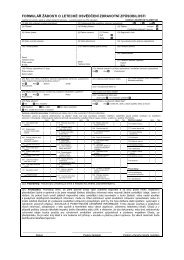
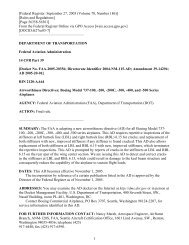
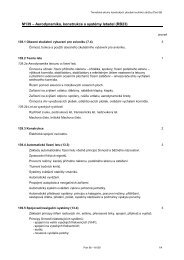
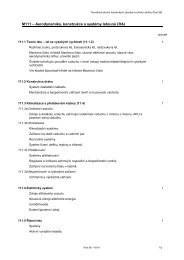
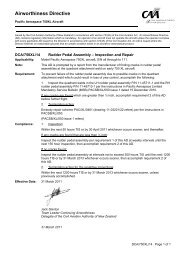
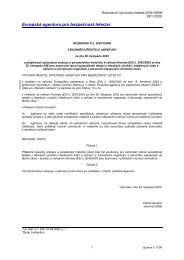
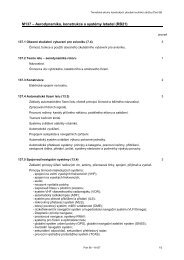
![AD 2010-0014 [PAD 09-006] Eurocopter ...](https://img.yumpu.com/50958012/1/184x260/ad-2010-0014-pad-09-006-eurocopter-.jpg?quality=85)
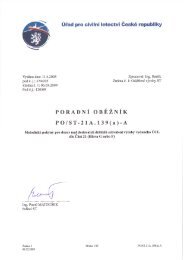
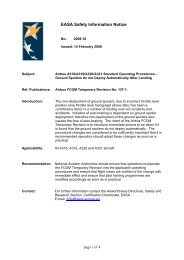
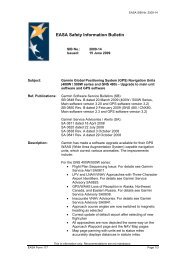
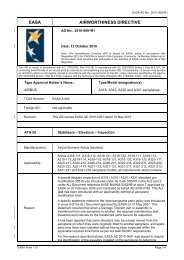
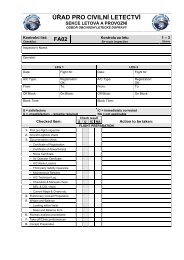
![1 [Federal Register: April 7, 2005 (Volume 70, Number 66)] [Rules ...](https://img.yumpu.com/49722490/1/190x245/1-federal-register-april-7-2005-volume-70-number-66-rules-.jpg?quality=85)
